Using gravestone clues to grow your family tree may be one of genealogy’s best-kept secrets!
Do you have some brick walls in your family tree? A trip to the cemetery may be just the thing to help you break through!
What a Clue Can Do
Gravestones can provide information about the individual who is buried there, the family members who selected their gravestone, and the community at large.
Clustered death dates in a cemetery can reveal patterns of disease, war, or disaster.
The designs, symbolism, and text on gravestones make statements about both individual and community beliefs about life and death. And more often, beliefs about the afterlife.
Gravestones function as a journal of sorts – one written in stone. It may be only place in the world where you may discover which religion, clubs, fraternities, or occupations influenced the daily life of your ancestor.
From there, you can take that information and seek out the churches, townhalls, meeting halls, or work places that may have more information about your ancestor. And the next thing you know, your family tree has grown another branch!

A Gravestone Detective
Carin Cornwall Cooper is an expert at cemetery hopping! She is from Arizona in the United States but is living in Ballymena, County Antrim, Northern Ireland, the land of her own ancestors. So she takes regular trips to local cemeteries to see what she can find to grow her own family tree.
Carin’s favorite graveyard is the Quaker Lynastown Burial Ground located in Lurgan.
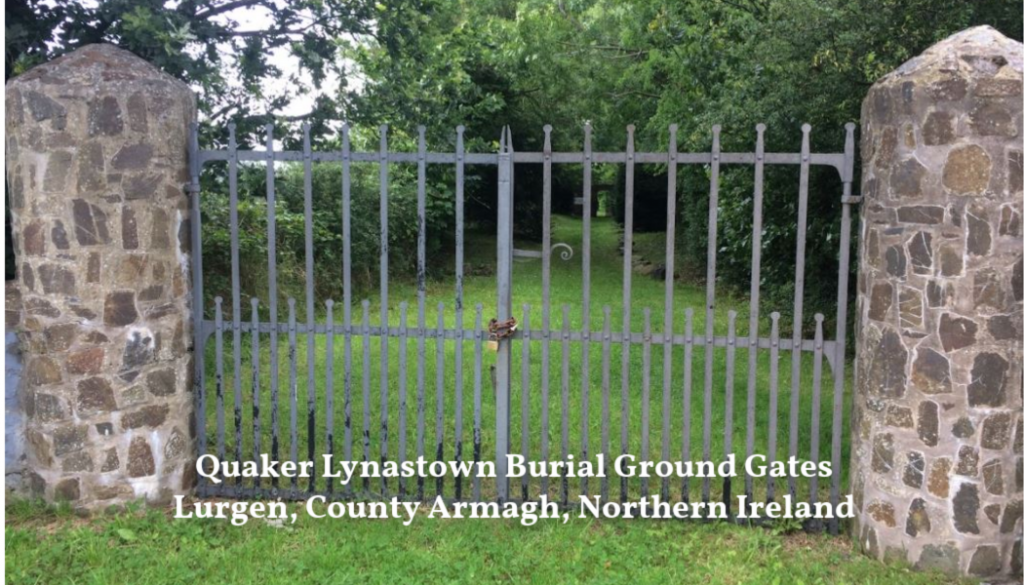
Carin said, “I went looking for my great-great-great grandmother, Eliza Neill, wife of Alexander Cornwall, who died in 1859 in a little town called Gilford, Co. Down (just 7.5 miles south of Lurgan).
“Her husband left for America after her death but we don’t know where she was buried. She and her family were Quakers so I went looking for her in Quaker burial grounds.
“Long story short,” she said, “I couldn’t find her but I did find the resting place of her great-grandparents, John Neill I and Sarah Morton, who died 1704-1706. I never dreamed I would be able to locate where my great-great-great-great-great-great (that is so many greats!!!) grandparents were buried!”
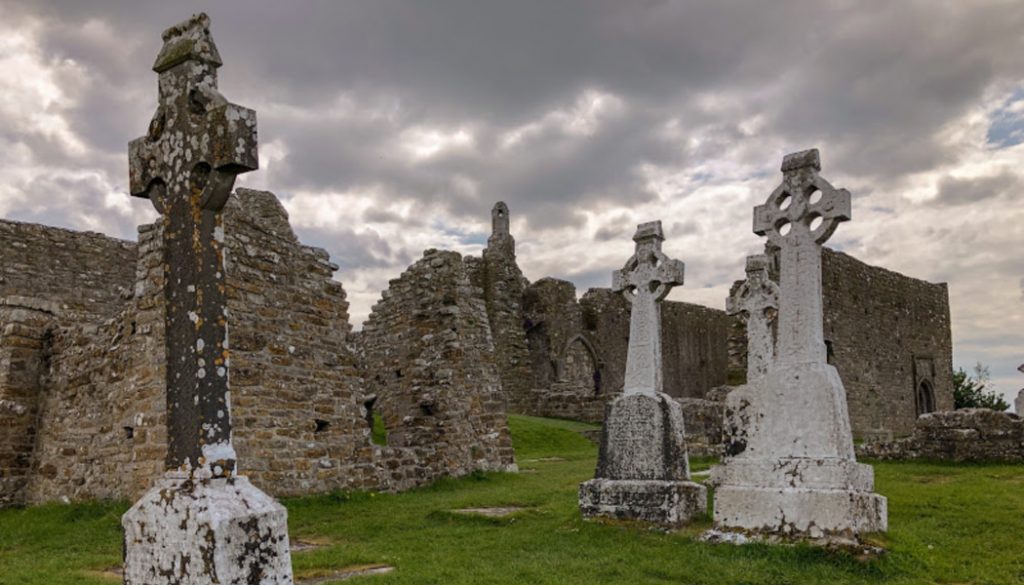
Carin was very fortunate! While finding the final resting place of ancestors that far back in our trees would be exceptional, even the smallest of gravestone clues can help to grow our family trees.
Below are ten gravestone clues to grow your family tree.
Gravestone Clues to Grow Your Family Tree #1: Birth and Death Dates
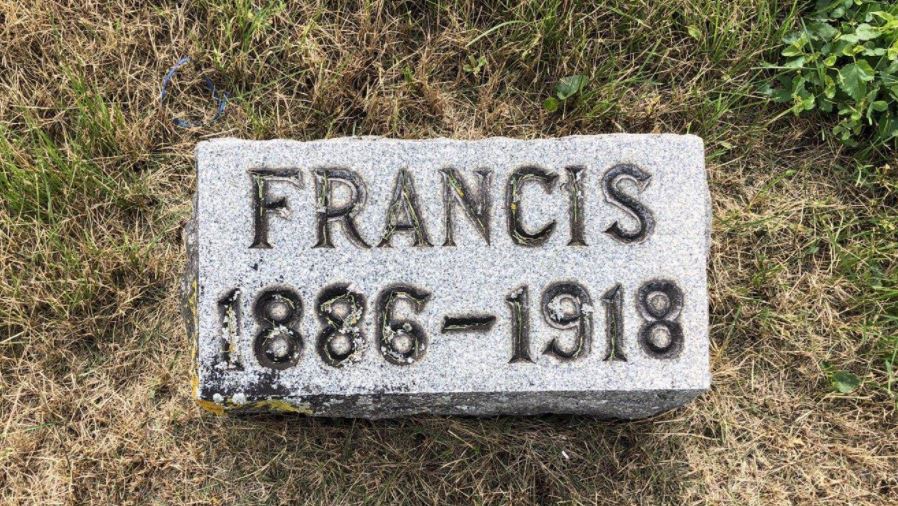
Most gravestones have both birth and death dates.
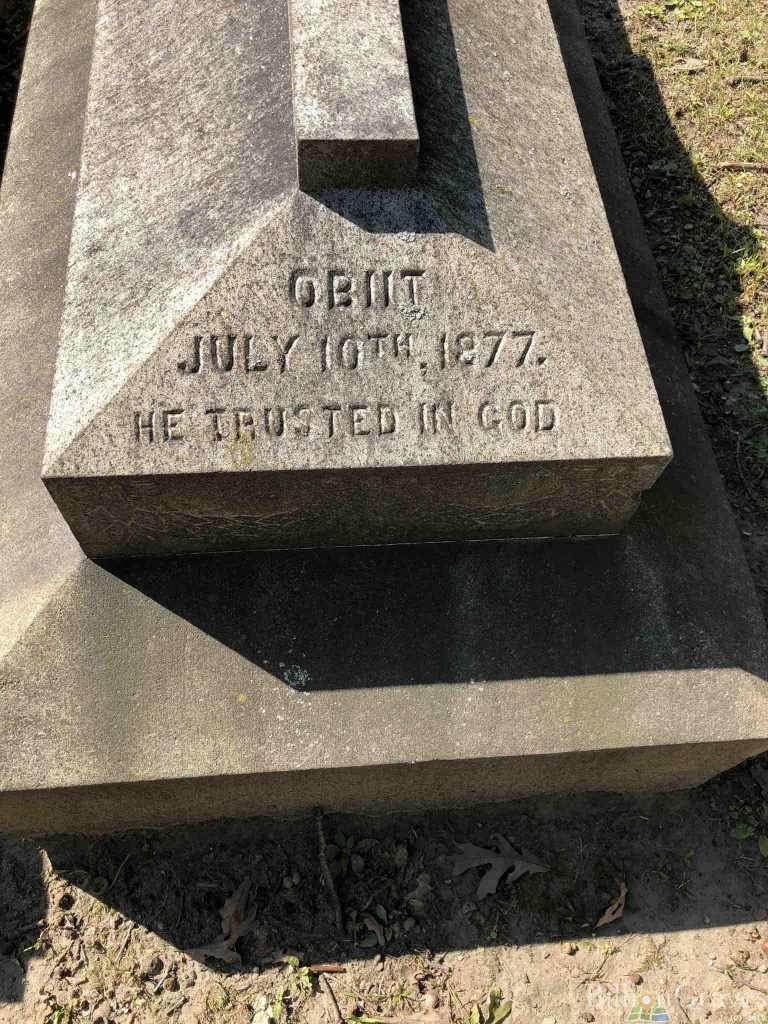
But some have only one date. If you see a gravestone with only one date on it, that will typically be the death date.
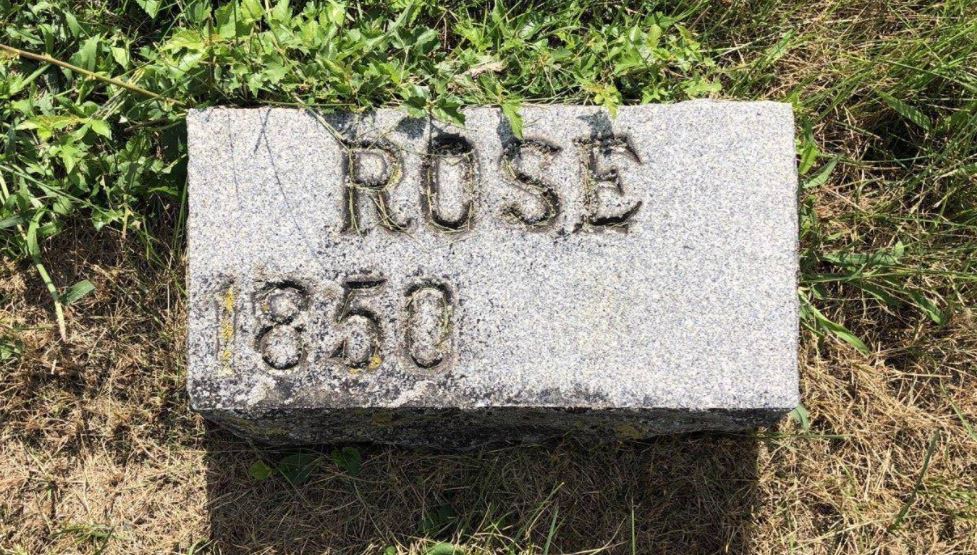
But not always. Sometimes the only date on the gravestone is on the far left side, with a blank space to the right.
This usually means that gravestone was erected before that person died. Then either they have not died yet or, in the case of most older gravestones, family members did not have the death date inscribed after the person died.
Gravestone Symbols about the Length of Life
Even if there is not a complete set of dates on a gravestone, the symbolism on the gravestone itself will sometimes give clues as to the length of life.
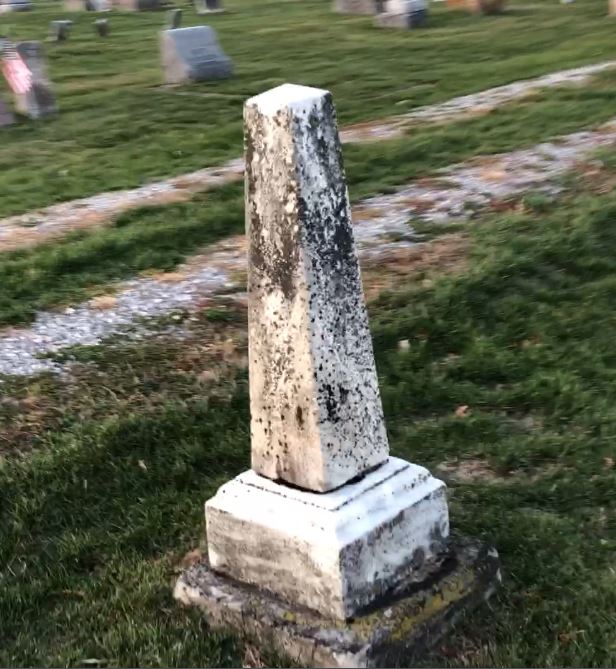
Broken Obelisk
At first glance, it may appear that this obelisk gravestone is missing its upper half because it is broken or has deteriorated.
But many broken obelisks were purposely created this way to signify that the deceased person’s life was cut short. Broken obelisk gravestone symbols were often used for the head of a family.
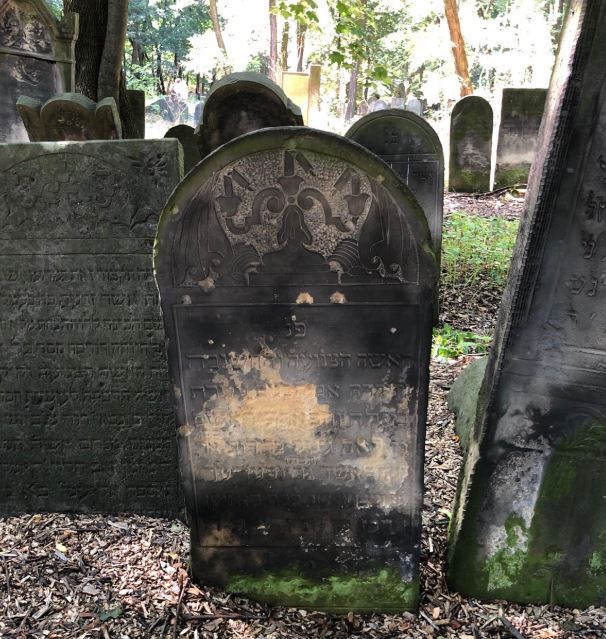
Candlesticks on a headstone usually symbolize the final resting place of a Jewish woman.
This is due to the fact that when the candles are lit in a Jewish home on Friday evenings at sundown, it is traditionally the woman of the house who waves her hands over the candlesticks three times to welcome in the Shabbat (sabbath).
The candles in the candlesticks on this gravestone are broken, which signifies that the life of this woman was cut short. In other words, she died young.
To learn more about Jewish gravestone symbols, click HERE.
Lamb

Lambs are a common symbol on children’s gravestones, representing innocence and purity.
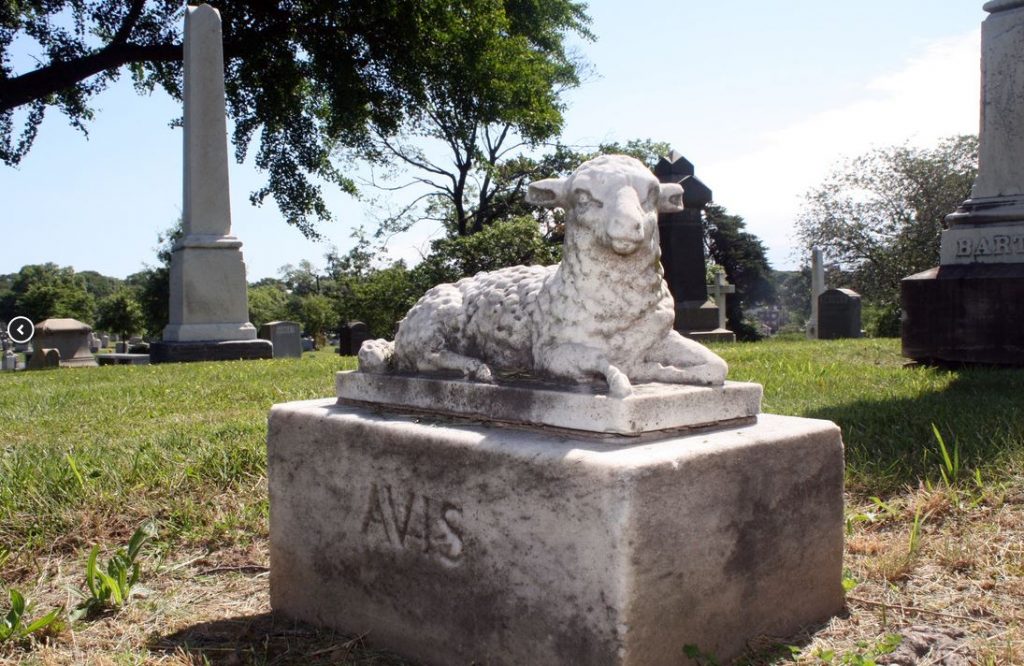
So if you see a gravestone in one of your ancestor’s family plots with a lamb but no dates, you could safely assume that it is the final resting place for an infant or child.
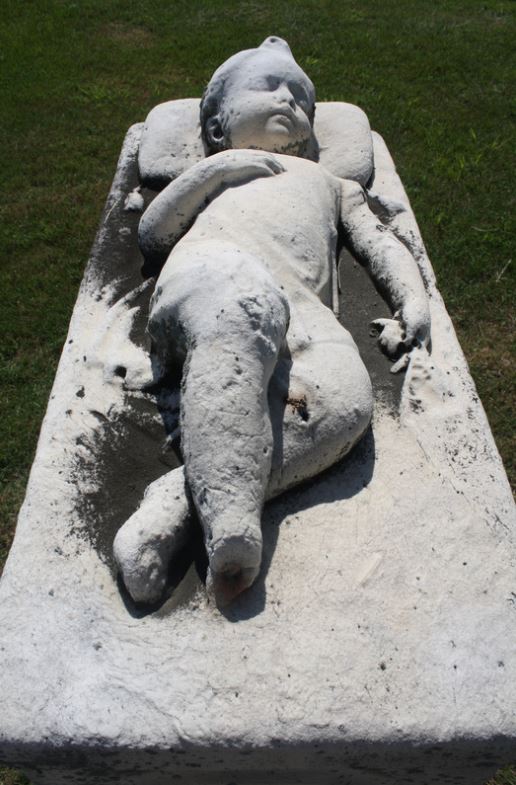
Sometimes family members find comfort in putting a likeness of their child on a gravestone.
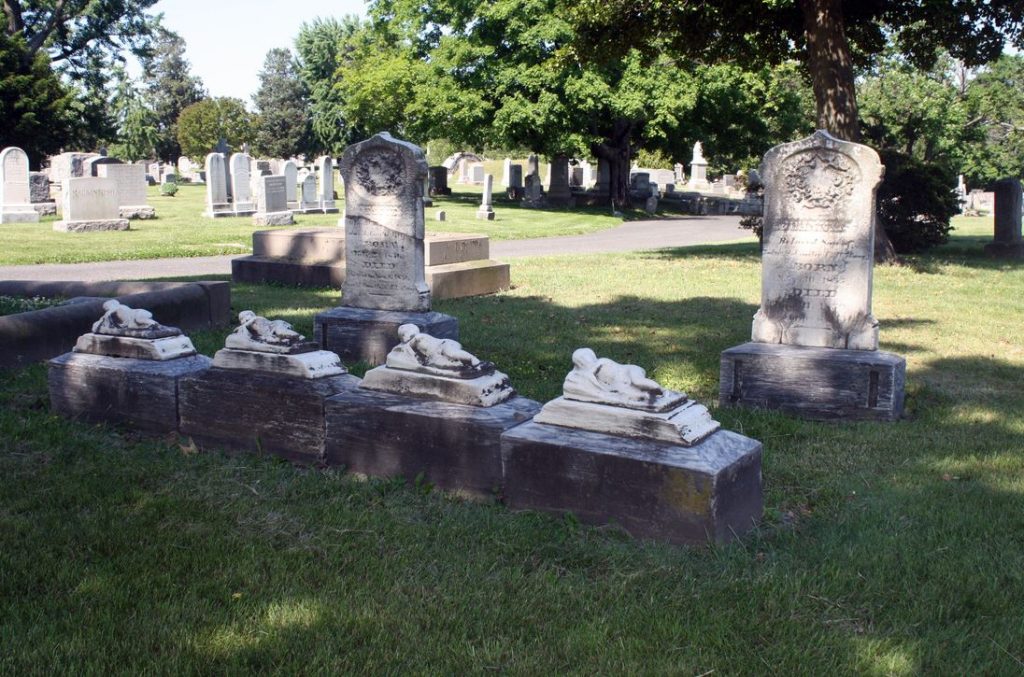
Sadly, this family plot in Glenwood Cemetery in Washington D.C. has a whole row of infant graves.
You can look for other clues related to dates when you are at a cemetery. Are there lots of headstones from one particular year? If so, why might that have happened? Could there have been an epidemic? A war? A natural disaster?
Gravestone Clues to Grow Your Family Tree #2: Cause of Death
Sometimes gravestones list the cause of death. This is not only an interesting fact to add to your family tree, but it can also be helpful for your family’s medical history.
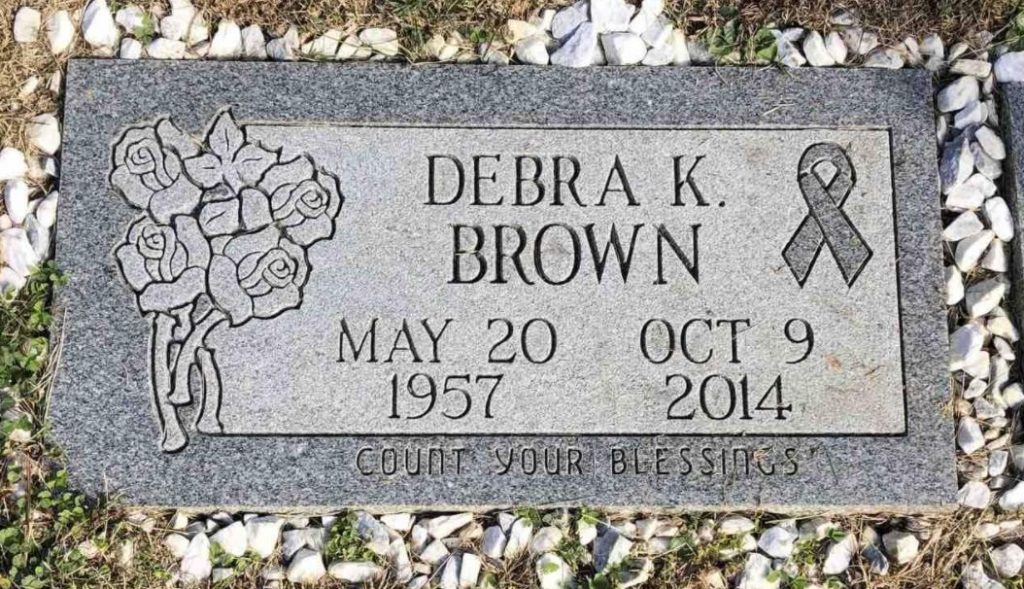
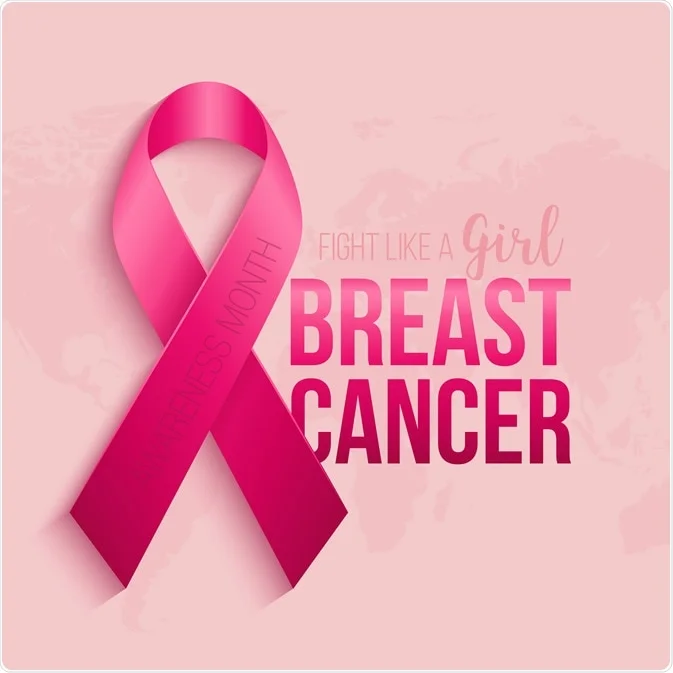
The gravestone above indicates the deceased’s cause of death was cancer.
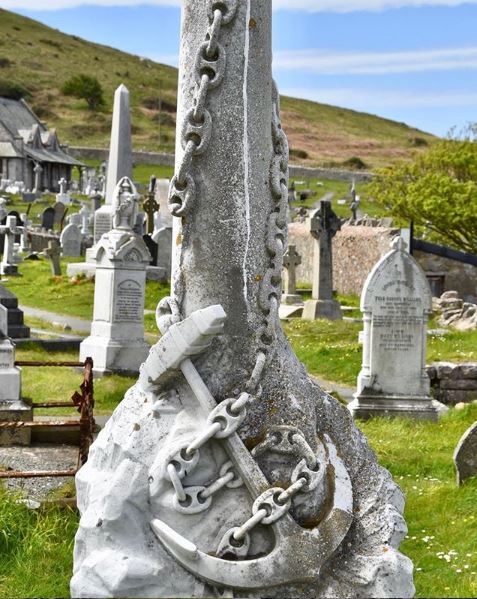
If someone died at sea, it is often noted on their gravestone.
Gravestone Clues to Grow Your Family Tree #3: Find Additional Family Members

Approximately 70% of all people are buried in family plots. That is a bonus for genealogists because when you find one, you find them all!

The family plots at Woodlands Cemetery in Philadelphia, Pennsylvania are neatly bordered with stone barriers. Each one has the family names inscribed on a step at the entrance.
Use BillionGraves Plus to Discover Burial Proximity
Every gravestone that is photographed with the BillionGraves app is automatically tagged with GPS coordinates! This allows the graves to be plotted on a map and it makes them searchable.

When you enter a name on BillionGraves website to search for your ancestor you will be able to see where they are buried in the cemetery and who is buried nearby.
You can also search for ancestors on your smartphone using the BillionGraves app when you are at a cemetery and then use the map to walk straight to their gravestone. Click HERE to learn how.
Searching for your ancestors on the BillionGraves website is free. But you can get even more out of BillionGraves’ burial proximity feature by using BillionGraves Plus, which is an optional subscription upgrade. Learn more about BillionGraves Plus by clicking HERE.
BillionGraves automatically tags gravestone photos with GPS coordinates. Learn about the difference between BillionGraves and Find A Grave by clicking HERE.
Family Trees in Stone

As genealogists, don’t we wish every gravestone was as thorough as this one? What a treasure! It is a whole family tree engraved in stone. (Photo source)
Look for a Change in Family Names Over the Years
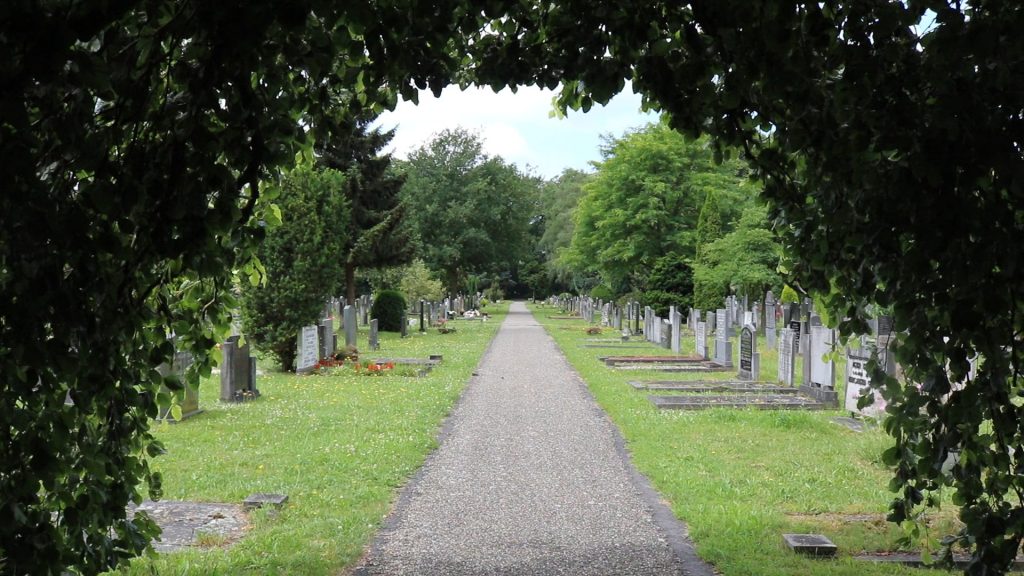
Compare the last names on the older stones with those on the more recent gravestones within family plots. Did the family name change over the years?
This sometimes occurred when families immigrated to a new country so this can be a great clue for you to then go look for immigration records from a particular time period.
Maiden Names
Maiden names can be one of the best gravestone clues to grow your family tree.

This is a French gravestone. The word “nee” means “born” and when it is seen on a gravestone it indicates the woman’s birth name.
So in other words, this is the grave of Madame Kislique, who was known as a child as Rose Guizard.
Finding a maiden name on a gravestone may allow you to add a whole new branch to your family tree!
Gravestone Clues to Grow Your Family Tree #4: Talents
Gravestones can even reveal your ancestor’s talents. As you learn more about your ancestors, you will learn more about yourself. Maybe you even share the same talents?
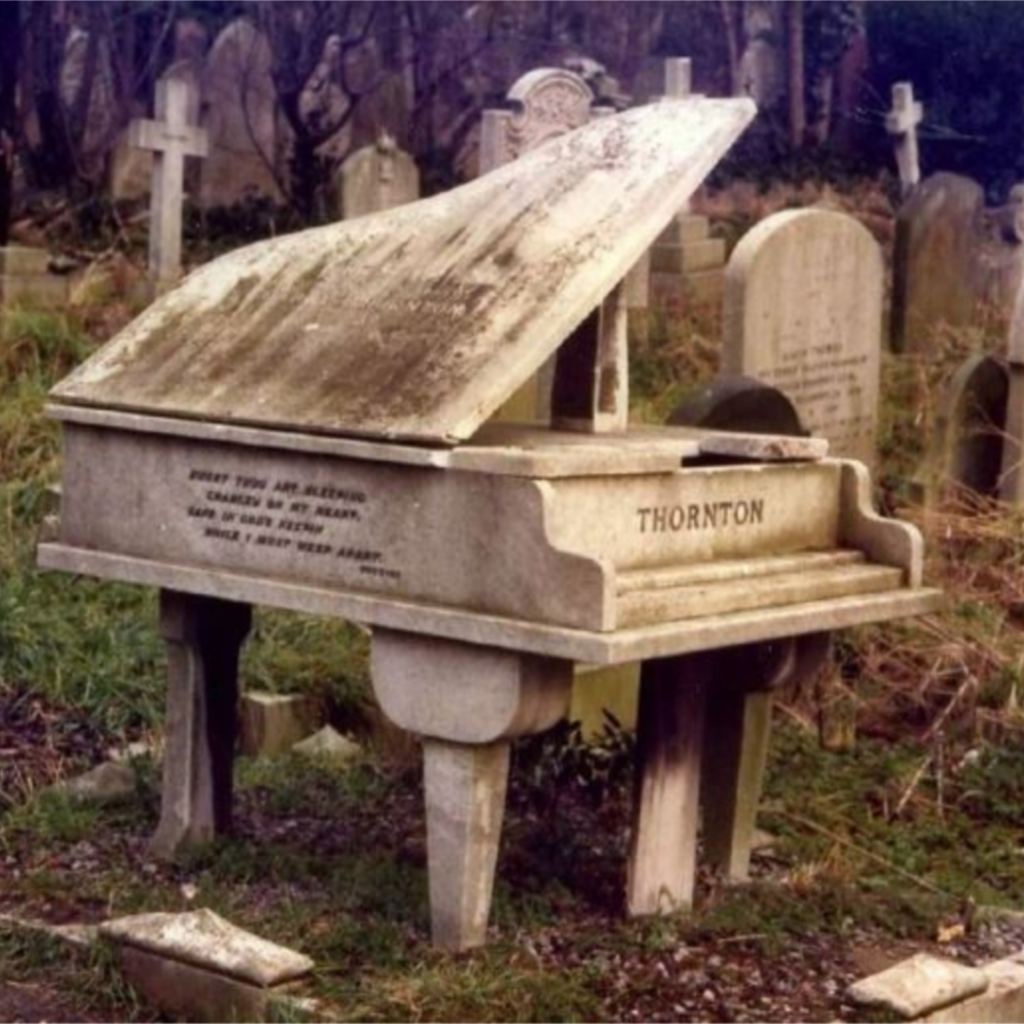
Did your ancestor play the piano?
This marble piano is the gravestone of Harry Thornton, a concert pianist. He and his wife entertained troops during the First World War. Thornton died during the 1918 flu epidemic and is buried at Highgate Cemetery in London, England.
The epitaph on the side of the piano reads, “Sweet thou art sleeping; cradled on my heart; safe in God’s keeping; while I must weep apart.”
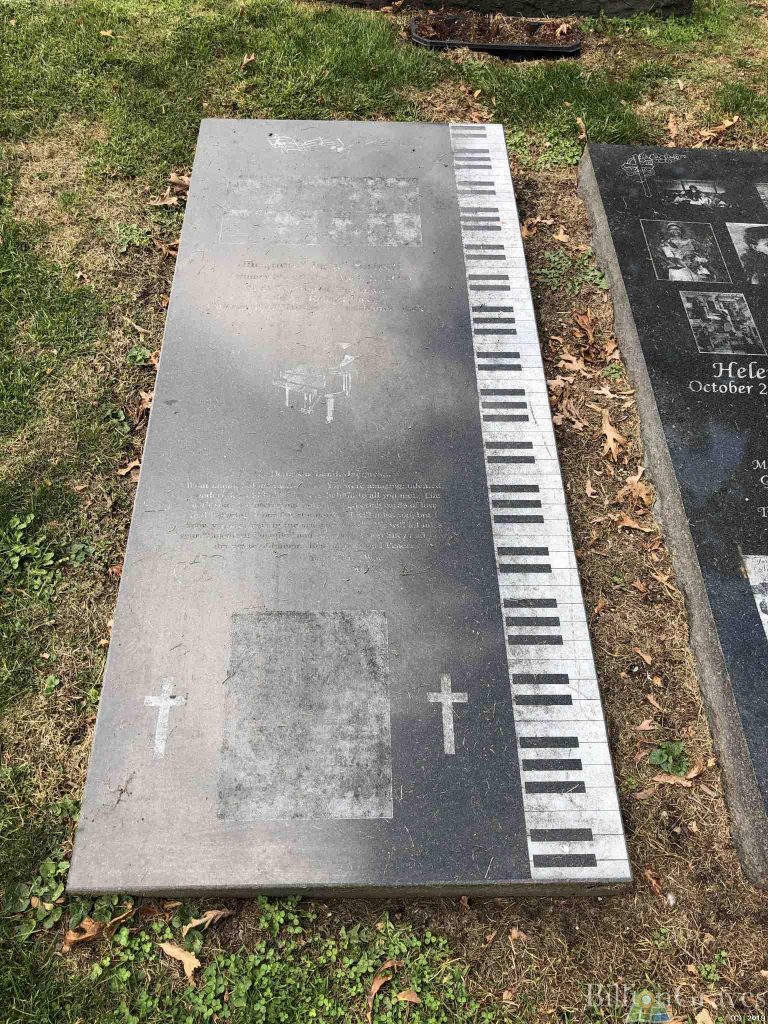
This is the gravesite of Helen Webb Surrell at Elmwood Cemetery in Detroit, Wayne, Michigan.
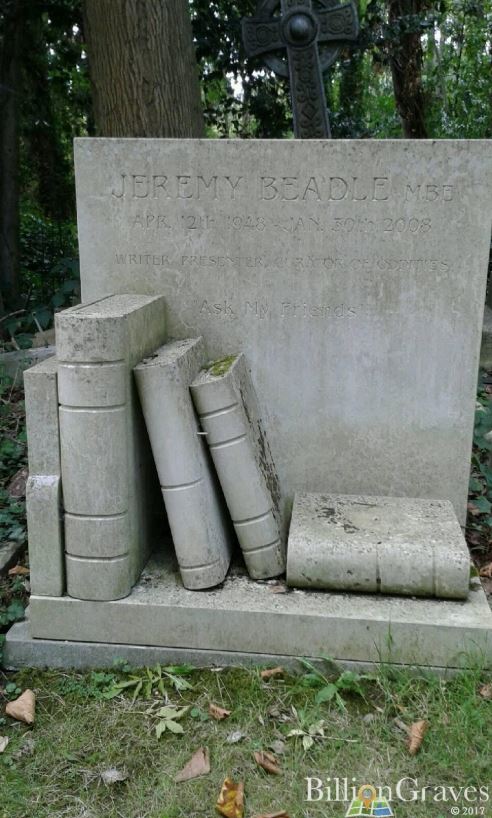
Jeremy James Anthony Gibson-Beadle (1948 – 2008) was an author, English television and radio presenter, and producer. As a youth, he was kicked out of school repeatedly for conducting wild pranks.
It has been said that he introduced himself as Jeremy James Anthony Gibson-Beadlebum: “Jeremy James Anthony Gibson-Beadle is my name and a bum is what I am.” (source)
Gravestone Clues to Grow Your Family Tree #5: Occupation
Knowing your ancestor’s occupation can give you clues about where they may have worked. If their employers are still in business, you may be able to find even more clues.
Click HERE to learn more about occupational gravestones.
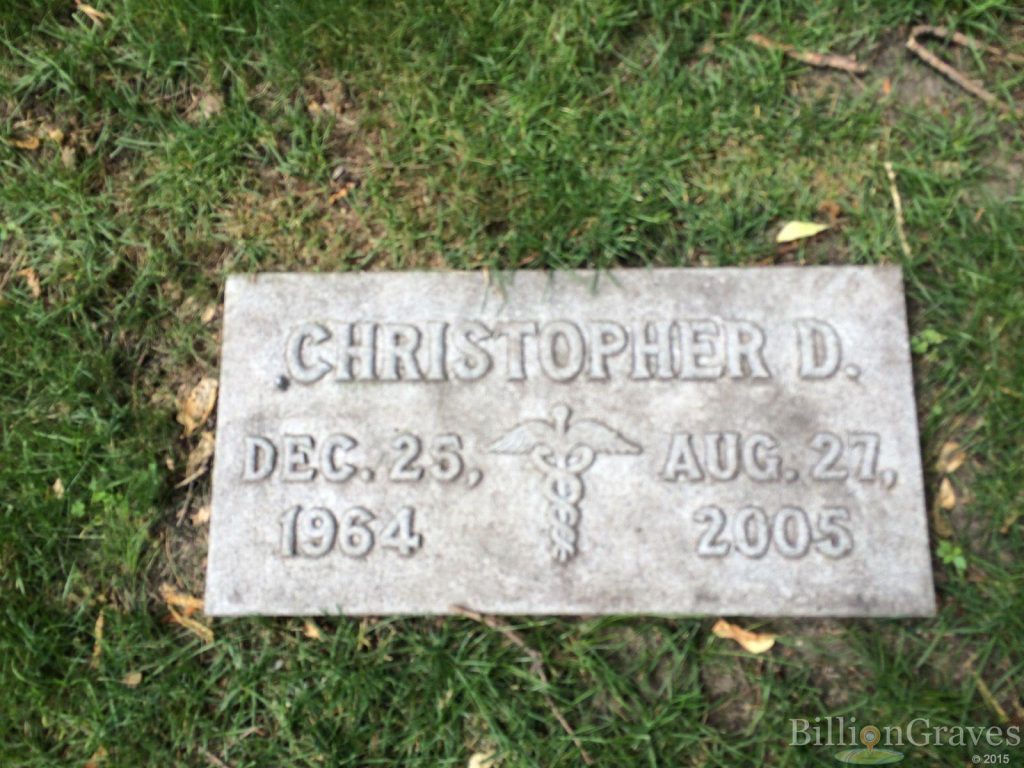
The symbol on this gravestone is representative of the medical field. It is seen on doctor’s lab coats, pharmaceutical packaging, hospital logos, and the like. The person buried here is likely a physician.
Find out more about this medical symbol by clicking HERE.
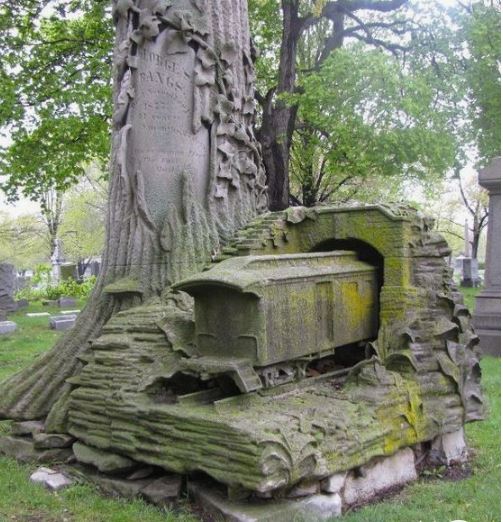
This train monument marks the final resting place of George Bangs at Rosehill Cemetery in Chicago, Illinois.
Bangs worked for the Railway Mail Service, where he developed a faster system for sorting mail on trains. The monument was paid for by his fellow postal workers, who had the epitaph on his gravestone inscribed with the words, “His crowning effort, fast mail”.
Gravestone Clues to Grow Your Family Tree #6: Military Service
Clues that your ancestor served in the military may be seen right on the gravestone itself or on military flag holders placed next to the gravestone.
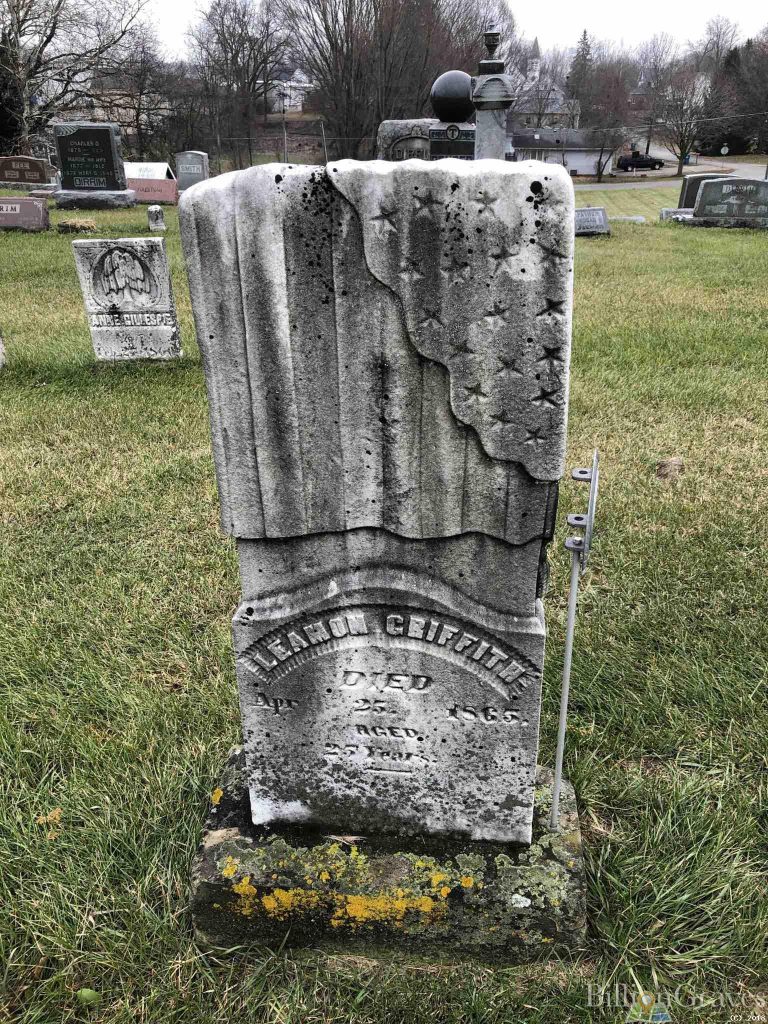
This is the gravesite of Leamon Griffith who died in 1865, the year the US Civil War ended. He is buried at Hamilton Cemetery in Hamilton, Indiana.
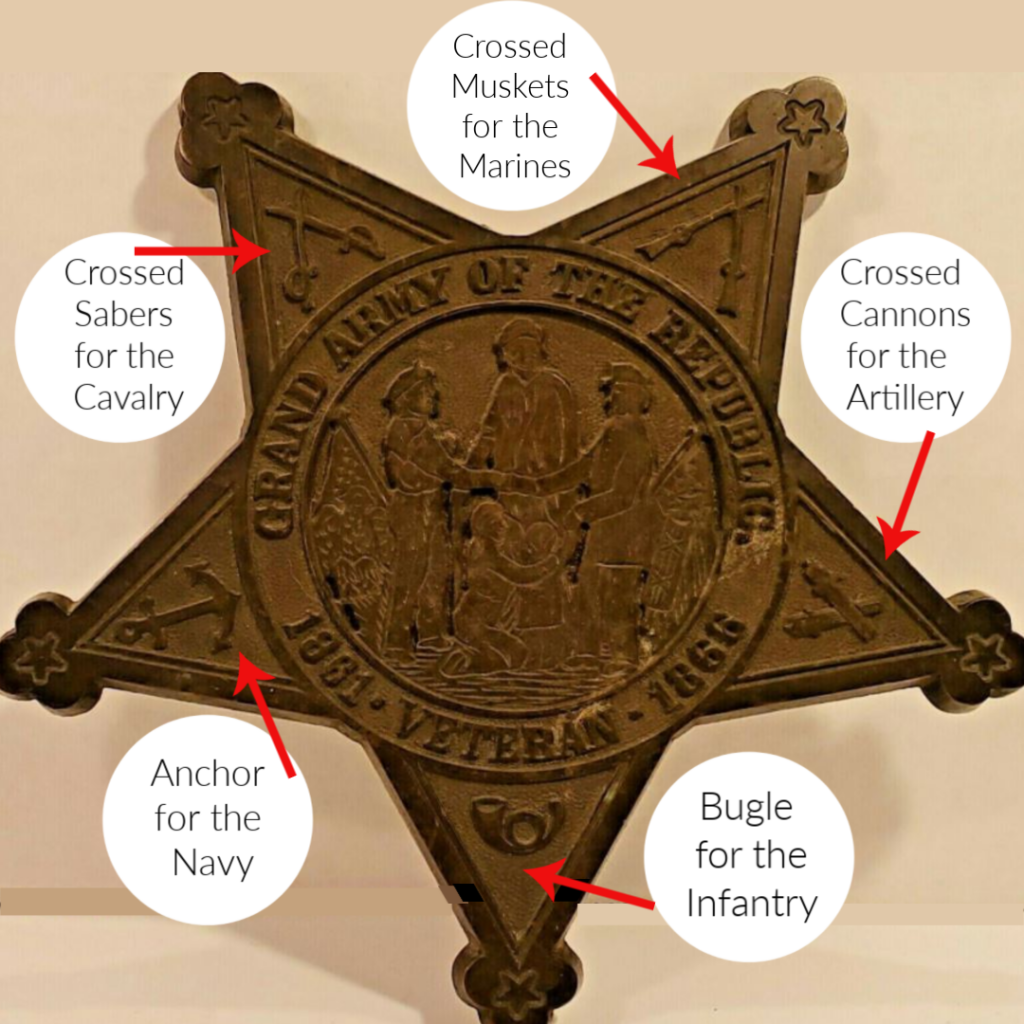
Military flag holders are unique for each war and sometimes specific to branches of service or even locations and regiments.
Once you have found military information at your ancestor’s gravesite, be sure to do some follow-up research by checking out military records. Click HERE for some useful tips on how to do that with FamilySearch.

Commodore David Porter was a naval officer in the War of 1812. He is buried at Woodlands Cemetery in Philadelphia, Pennsylvania.

This is just the base of his huge gravestone obelisk.
Porter’s epitaph reads: “His early youth was conspicuous for skill and gallantry in the naval service of the United States when the American arms were exercised with romantic chivalry before the battlements of Tripoli. He was on all occasions among the bravest of the brave, zealous in the performance of every duty, ardent and resolute in the trying hour of calamity, composed and steady in the blaze of victory.”
From gravestones like this, you can learn not only the occupation but the personality of the deceased.
Gravestone Clues to Grow Your Family Tree #7: Religion
Gravestones symbols can help you figure out your ancestor’s religion. Once you know if they were Methodist, Jewish, Russian Orthodox, Buddhist, or another religion, you can check out local places of worship for more information.
You may find that older churches, synagogues, or mosques have books filled with christening, marriage, or other ordinance records.
Celtic Cross
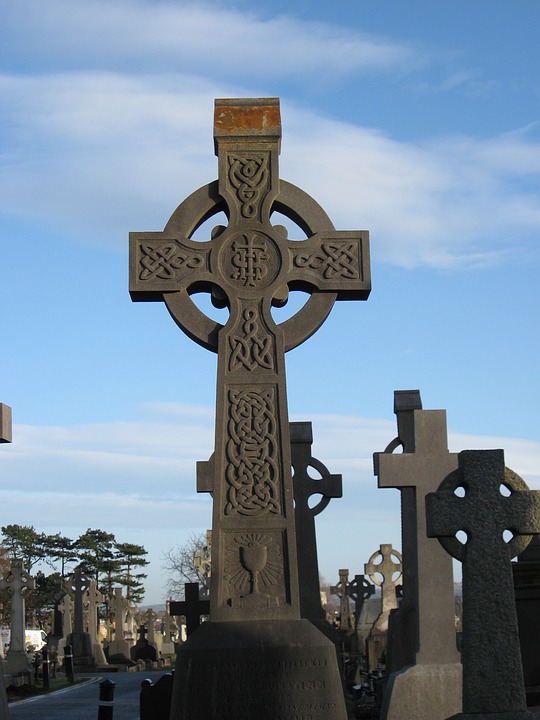
The Celtic cross has a ring or nimbus that connects the four arms. It originated in Ireland and Great Britain in the Early Middle Ages.
Irish legends hold that St. Patrick introduced the Celtic cross. Adherents claim St. Patrick combined the symbol of the Christian cross with the symbol of the sun, worshipped by pagans, to attract new believers to Christianity. Others interpret the placement of the cross on top of the sun as Christ’s superiority over the pagan sun gods.
The legends may be true, but it also may simply be that the circle gives structural support to the arms, so it was easier to create.
If your ancestor has a Celtic Cross at their final resting place, chances are good that you have an Irish or British heritage.
To learn more about Celtic crosses, click HERE.
Crucifix
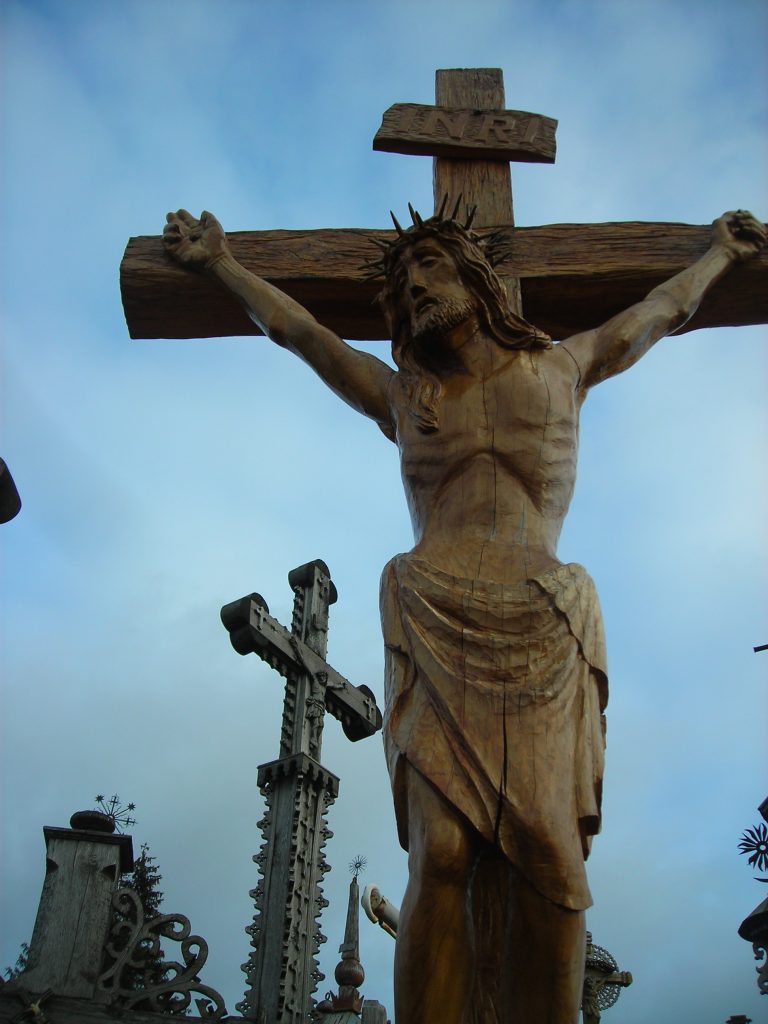
A crucifix is a cross with the figure of the suffering Christ on it. A crucifix on a grave is a clue that the deceased was Catholic.
This hand-carved crucifix stands about 12 feet high atop the Hill of Crosses in northern Lithuania. It depicts Christ wearing the plated crown of thorns placed on him by Roman soldiers. Nails pierce his hands and feet. There is a sign above his head with the letters INRI carved in it. These letters stand for the Latin words, “Iesus Nazarenus Rex Iudaeorum” or “Jesus of Nazareth, King of Judea.”
It was customary among the Romans to place a sign over the person being crucified to state their name and the crime for which they were accused. John 19:19 states that Pilate wrote a title that read, “Jesus of Nazareth, The King of the Jews.” In verse 20 John adds that the sign was translated into Hebrew, Greek, Aramaic, and Latin. The chief priests of the Jews sought to correct Pilate, asking him to rephrase the crime as “He said, I am King of the Jews.” Pilate refused, saying, “What I have written, I have written.”
To learn more about crucifix and other crosses, click HERE.
Priestly Hands
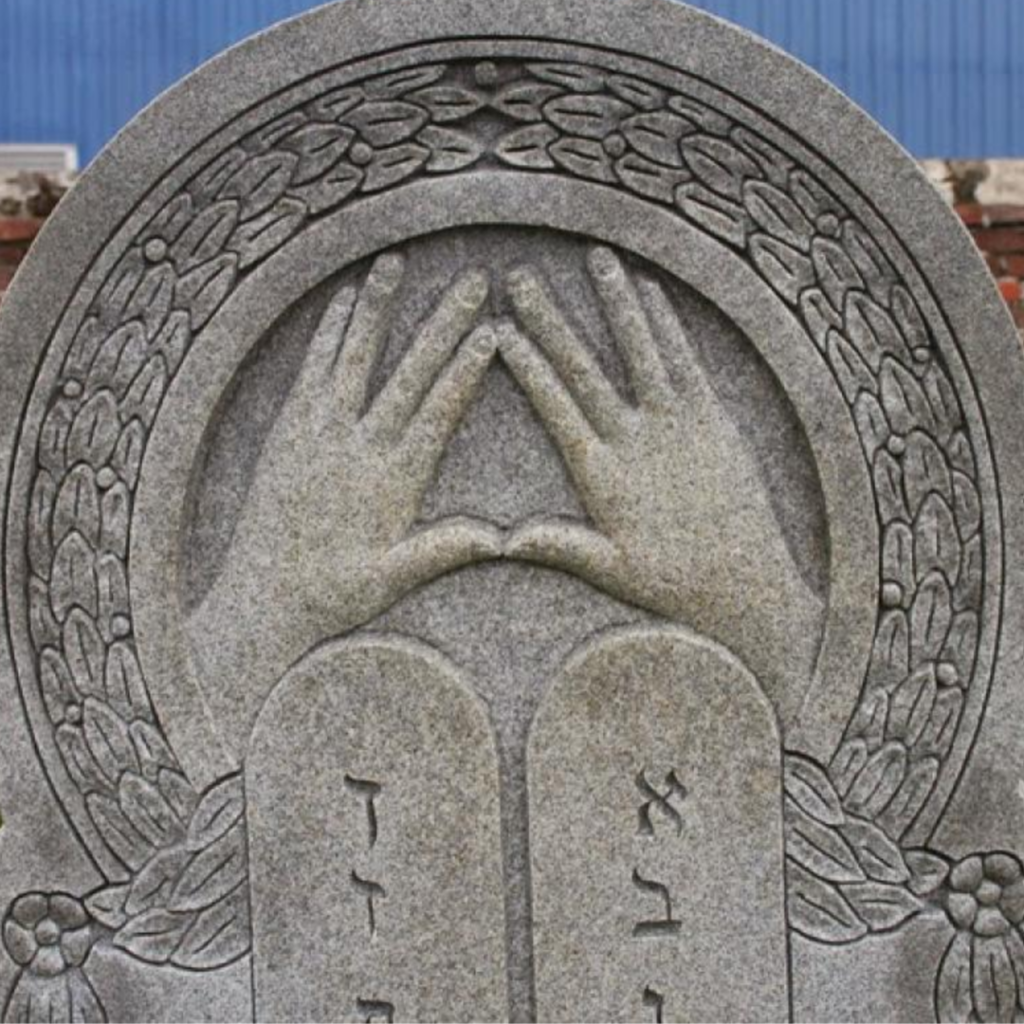
Hands that are held in this position are a symbol for those who have inherited a Jewish priestly heritage.
The majority of those who have this priestly heritage have had the last name of Cohen – a name which literally means “priest” in Hebrew. They are those who have descended from Aaron, the brother of the ancient prophet Moses.
Aaron’s priesthood rights have been passed down from generation to generation. Those who inherit this right or power use it to perform priestly duties.
One of their priestly duties is to hold their hands as pictured on these gravestones when offering an Aaronic benediction or blessing over the Jewish people.
To learn more about Jewish gravestone symbols, click HERE.
Temple
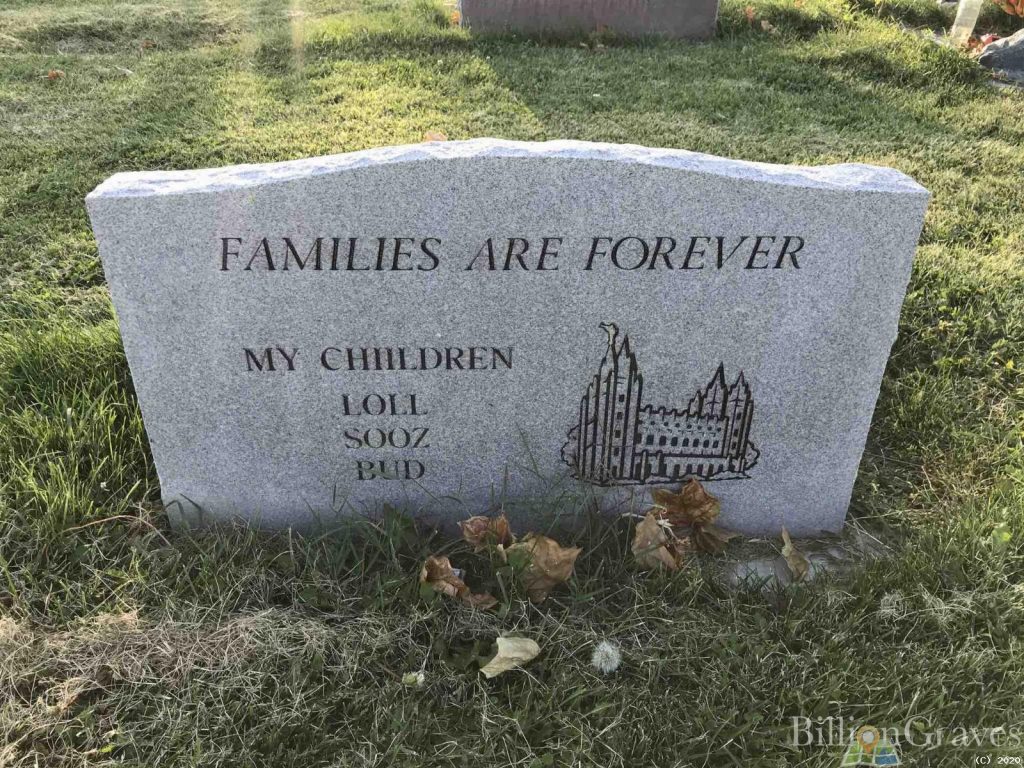
Members of The Church of Jesus Christ of Latter-day Saints often have the image of a temple engraved on their headstones.
This stems from their belief that married couples – and entire families – can be together forever when they have been “sealed” in the temple. This sealing ordinance unites them “for time and all eternity” rather than just “’til death do you part”.
It is comforting for family members who visit the gravesites of their departed family members to be reminded that their relationships are everlasting and that they will be together again.
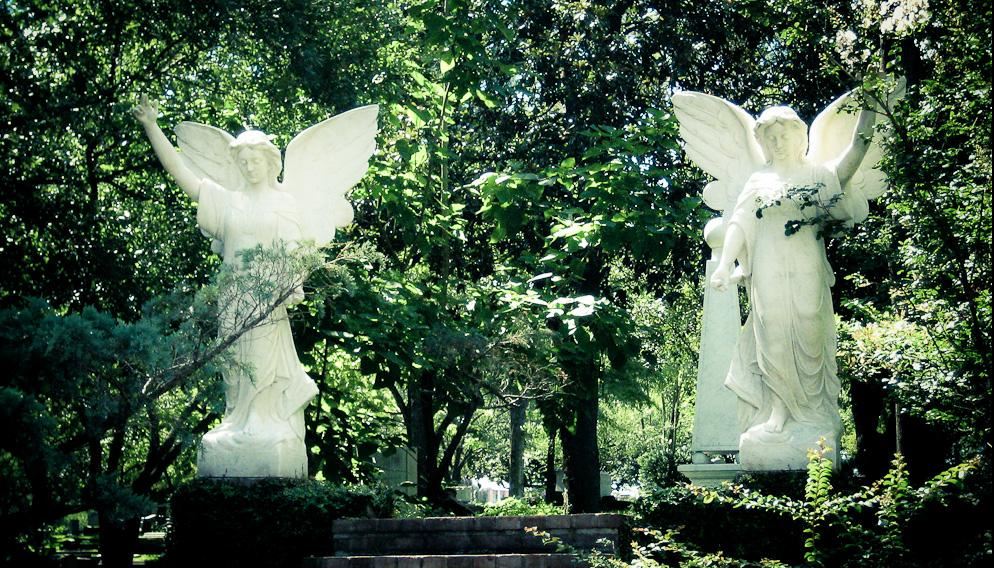
Some of the most touching graveside monuments are cemetery angels. Angels are spiritual beings that act as messengers for God. They offer guidance and protection for mankind.
Most major monotheistic world religions share a belief in angels, such as Judaism, Christianity, Islam. But angels on a gravestone usually indicate the person buried there was Christian.
Gravestone angels appear in many forms. There are angels dressed in flowing robes with feathery wings and joyful smiles. Others are serious guardians of the deceased, bearing swords. Some carry crosses or flowers. Some angels sit in front of scrolls with pens poised in their hands as they keep a written record of all we do and say.
To learn more about cemetery angels, click HERE.
Gravestone Clues to Grow Your Family Tree #8: Fraternal Organization or Club Memberships
Freemasons
Freemasons, with more than 6 million members worldwide, are the largest and most widely recognized fraternity. Members are commonly referred to as Masons and leaders become Master Masons.
As an occupation, a mason is one who uses bricks, concrete blocks, or natural stones to build structures. During the Dark Ages, most men were serfs to a king so their ability to travel was very limited. But men who were masons were free to move about so that they could work on construction projects in various locations. Thus they came to be known as freemasons.
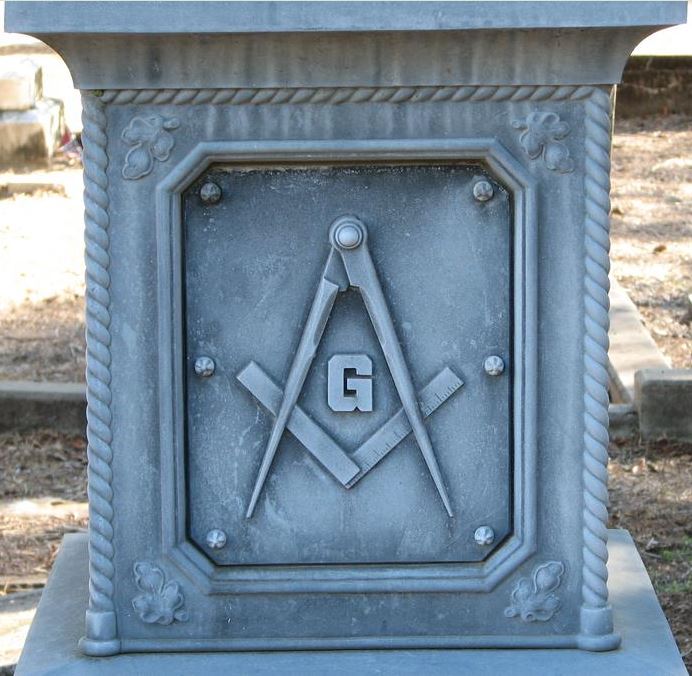
These freemasons were accomplished tradesmen, taking as long as 10 years to fulfill their apprenticeship and receive a degree. So they carefully guarded the secrets of geometry that they had learned as a part of their trade. Freemasons even identified one another with secret symbols and handshakes to be sure their coworkers were qualified.
Many of the beliefs and symbols of the Freemason fraternity are said to have been preserved from ancient times by the masons who worked on Solomon’s temple.
The most widely recognized symbol of Freemasonry is the square and compass with the letter G at the center. The letter G stands for both God and geometry. A belief in God is the main requirement for Freemasonry membership. And geometry is said to help unravel the wonders and mysteries of nature and the universe.
The square is a reminder to keep actions square and true with God and all mankind. It represents fairness, stability, balance, and having a solid foundation.
Since compasses are used to draw circles it is symbolic of infinite unending boundaries and spiritual eternity. The compass then deals more with the spiritual realm and the square with the earthly realm.
Together, the square and the compass represent both earthly and spiritual responsibilities. To the Masons, the symbol is a reminder to do well by all mankind on earth and to keep an eternal perspective in preparation for eternity with God.
To learn more about Freemasons and other social clubs, click HERE.
Odd Fellows
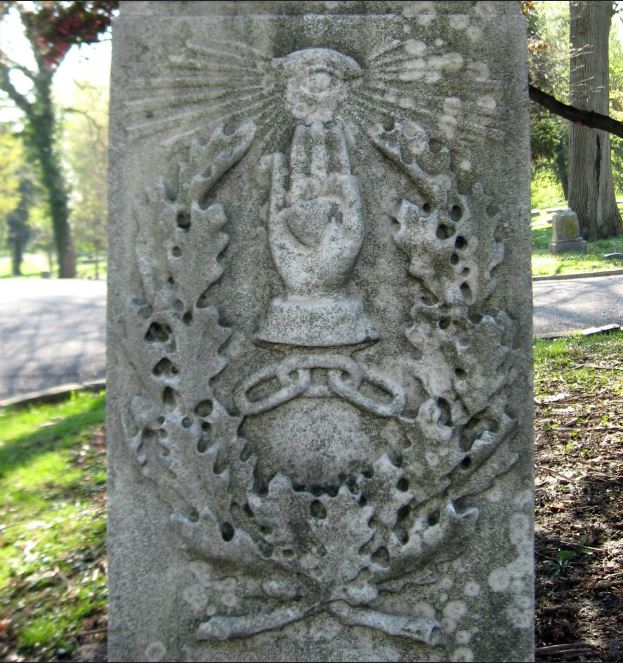
Some of the most common fraternity gravestone symbols you may see at the cemetery stand for the Independent Order of the Odd Fellows.
Why were these fellows called “odd” anyway?
In England during the 1600s and 1700s, people who fell on hard-times usually ended up destitute on the streets or in debtors prison. In an effort to combat this trend, some working-class men joined together to provide financial support for the unemployed, widows, and chronically ill.
Traditionally, it was family members or the wealthy aristocracy who took care of the indigent – not commoners. In fact, this idea was so out of the norm that their peers began to refer to these groups as “odd fellows.”
But they shrugged it off, embraced the name, and officially organized as The Order of the Odd Fellows. The Odd Fellows may have been peculiar folks, but they were also very charitable, and their acts of kindness began to attract thousands of members.
By the early 1800s the movement had spread to other countries. The Independent Order of Odd Fellows (IOOF) was founded in America in 1819. Today, there are more than 12,000 lodges in over 26 countries dedicated to humanitarian endeavors.
Odd Fellow Symbols
In the past, the Odd Fellows were considered a poor man’s version of the Freemasons and the two groups share some of the same symbols.
- IOOF – Independent Order of the Odd Fellows
- All-Seeing Eye – God sees all human thoughts and deeds
- Rays of the Sun – the blessings of God descend upon all mankind
- FLT – friendship, love, and truth
- 3-Link Chain – the principles of friendship, love, and truth must endure and never be broken
- Ax – human characteristics that do not bear good fruit must be cut down, just as an ax fells a sickly tree
- Bundle of sticks – breaking a single stick is easy, but breaking several at once is nearly impossible; in unity there is strength
- Heart in Hand – cheerful giving
- Handshake – friendship
- Oak Leaves – enduring love
To learn more about Odd Fellows and other fraternities, click HERE.
Gravestone Clues to Grow Your Family Tree #9: Birth and Death Place

Most gravestones list only the place of death, but you may be fortunate enough to find some that list the place of birth.
The photo above is of my own great-great grandfather Amos F. Wood’s gravestone. He is buried in Michigan but was born at Woodville, New York.
Woodville was named after the Wood family, so learning where this branch of the family lived opened up a wealth of genealogical treasures.
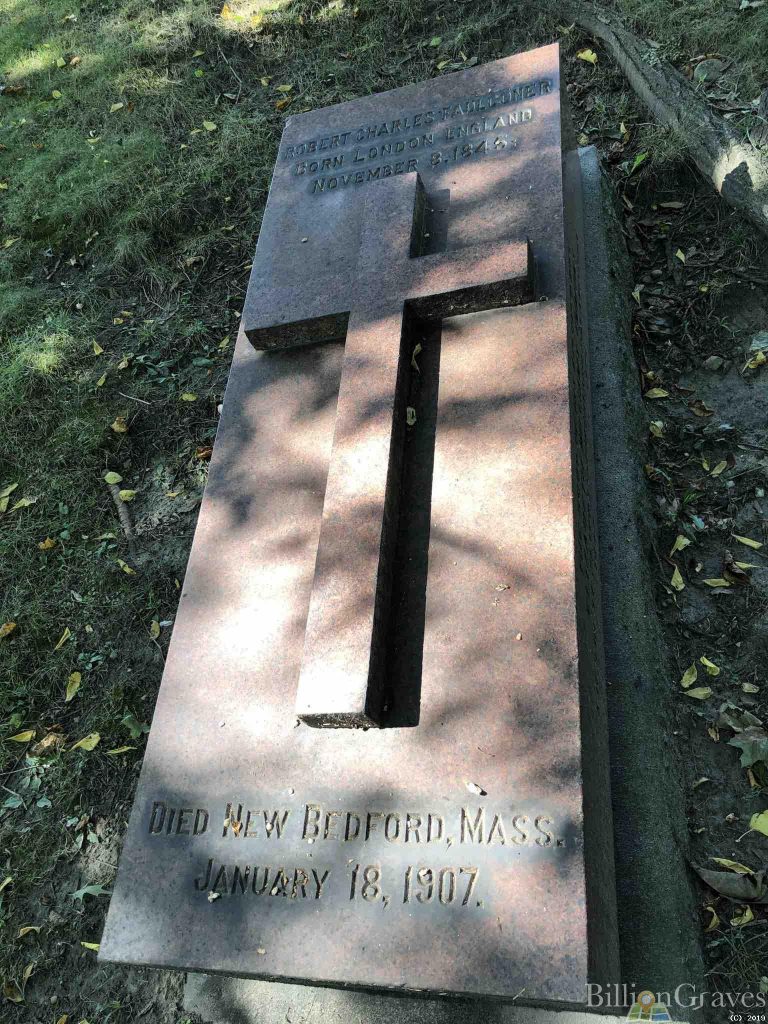
This gravesite for Robert Charles Faulconer is at Elmwood Cemetery in Detroit, Michigan. The headstone lists both his birth and death place. Surprisingly, neither one is in Detroit, Michigan!
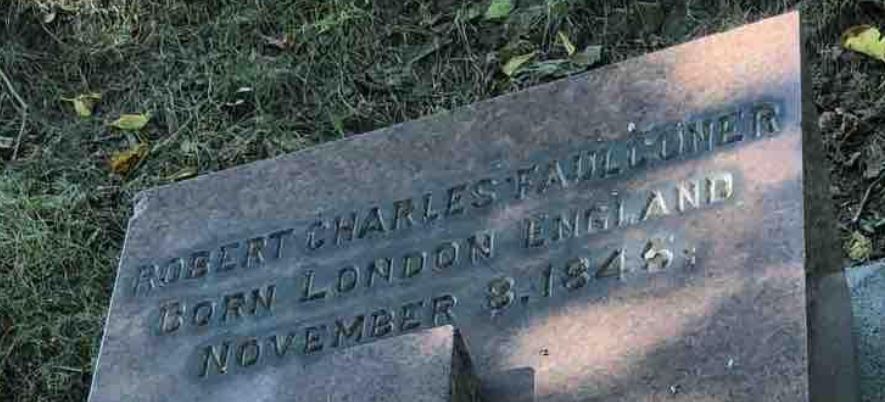
Faulconer was born in London, England.
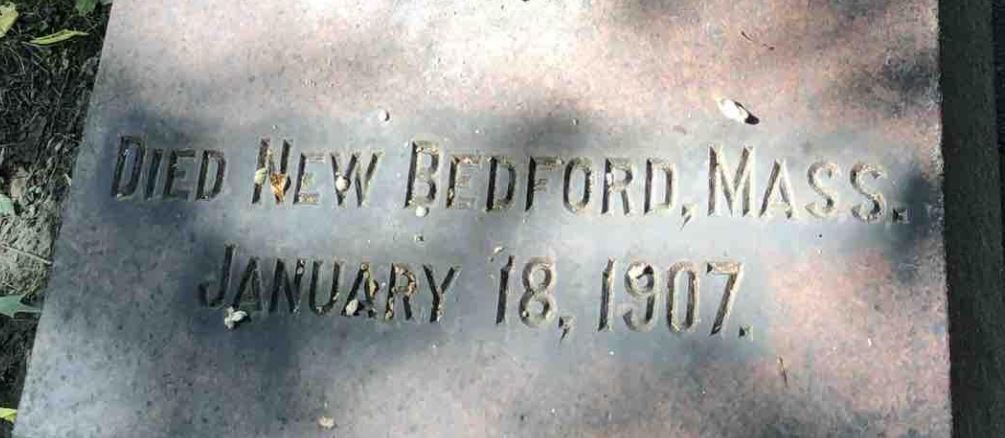
And he died in New Bedford, Massachusetts.
Gravestones with both birth and death places are fantastic gravestone clues to grow your family tree.
Gravestone Clues to Grow Your Family Tree #10: Social Status
Compare the styles of gravestones. Elaborate or massive headstones with statues or ornate
carvings may suggest wealth and high status.
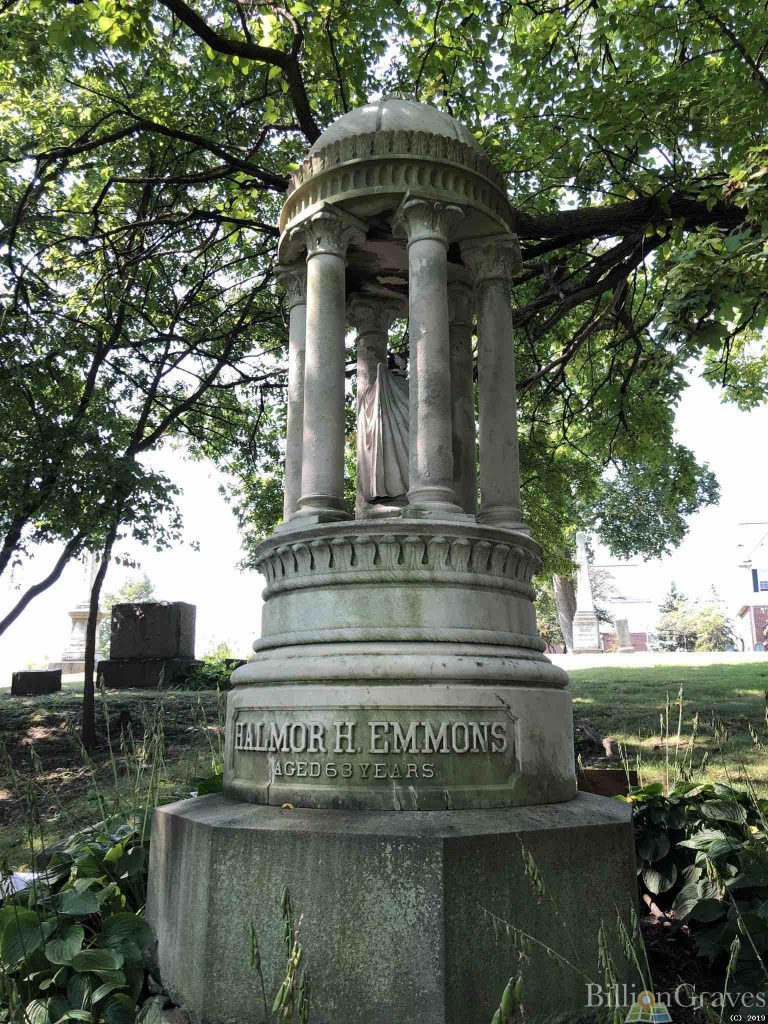
The craftsmen who made such elaborate gravestones were often justly proud of their work so they put a marker on it to indicate that it was their handiwork.
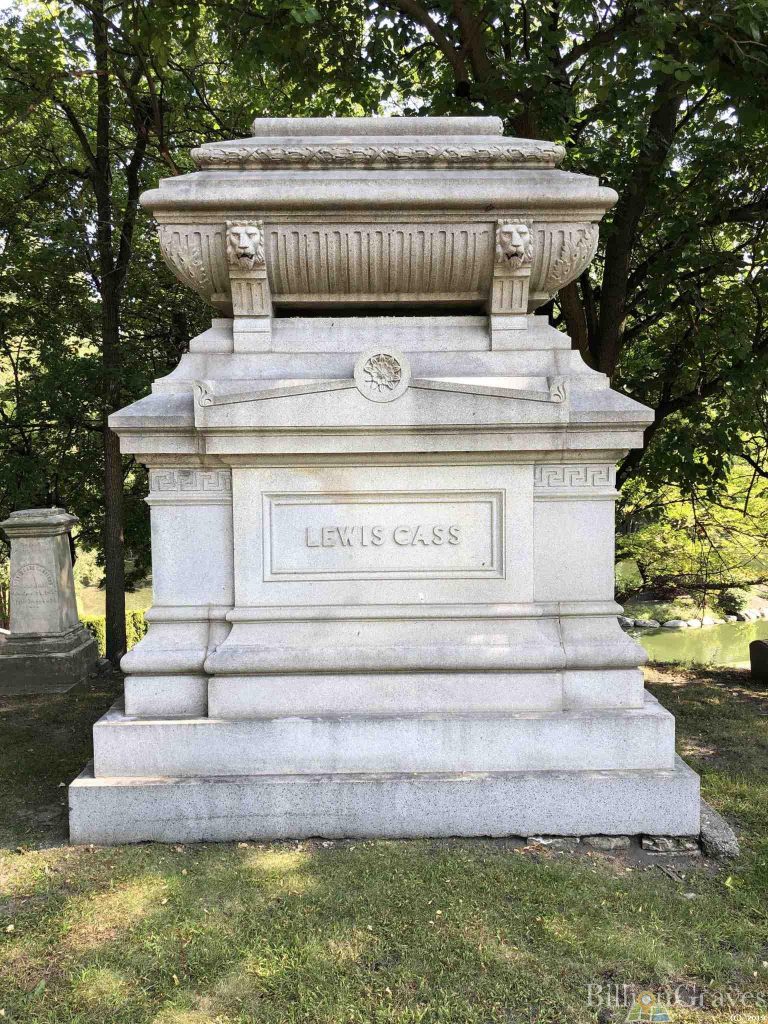
If that monument company is still in existence, you could contact them to see if they have further information about the family that ordered the memorial. You may find some additional family members this way.
This is the gravestone of Lewis Cass (1782 – 1866), an American military officer, politician, and statesman. He represented Michigan in the United States Senate and served in the cabinets of two U.S. presidents, Andrew Jackson and James Buchanan. He was also the 1848 Democratic presidential nominee.
Gravestone Clues to Grow Your Family Tree #11: Prefix and Suffix
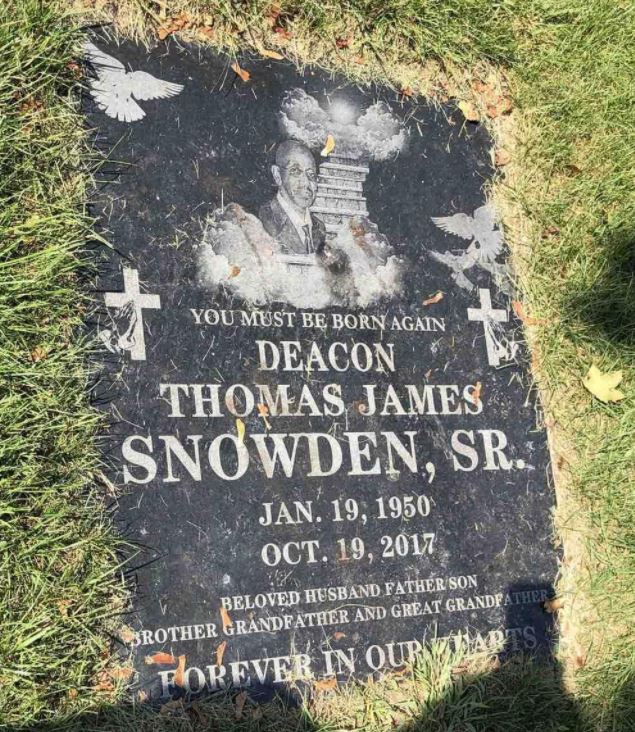
Gravestones may sometimes include prefixes and suffixes. This one has the title of “Deacon” and a suffix of “Sr.”
These tiny clues reveal the occupation of this man and the name of one of his sons. Both clues can be important to your family history.
Gravestone Clues to Grow Your Family Tree #12: Heritage and Culture
Your ancestor’s gravestone may hold clues for your family’s national heritage.
French
This gravestone below is in Philadelphia, Pennsylvania, but its style is French.

The French often created beds of flowers over gravesites.
Native American and First Nations

Native American or First Nations gravestones in Alaska and Canada often feature the animal that represents their family’s clan. Some are carved from wood and others from stone.

Anciently, the Beaver Clan lived in skin-covered tepees in the winter and brush-covered lean-tos or tepees in the summer. They usually traveled by canoe.

The Bear Clan was made up of both warriors and medicine-gatherers in the Anishinaabe tribe.
Once you know your family’s national heritage, do some research to find out what cultural traditions, food, and lifestyles influenced their day-to-day life during the time period that they lived.
Ask Questions
To find additional clues about your ancestors in large cemeteries, go to the cemetery office to ask questions.
- Are there any famous people buried in the cemetery?
- Were they alive at the same time as your ancestors?
- How could that have impacted your ancestor’s life experiences?
- Is there a section in the cemetery for war Veterans?
- Those who died in an epidemic?
- Or is the cemetery laid out in family plots?
- Are there particular cemetery sections for different ethnic groups or race?
- Were the rich buried in a separate area from the poor?
- Is there anyone in the area that is still living that may have information about your family?
BillionGraves
Of course, it isn’t always possible to visit a cemetery in person. So you can rely on BillionGraves to help you out.
As you photograph your cemetery, and I photograph mine, we will all be able to find our ancestors!
If you would like to volunteer to take gravestone photos with your smartphone click HERE to get started.
You are welcome to do this at your own convenience, no permission from us is needed. If you still have questions or concerns after you have clicked on the link to get started, you can email us at Volunteer@BillionGraves.com. We’ll be happy to help you!
Happy Cemetery Hopping!
Cathy Wallace


